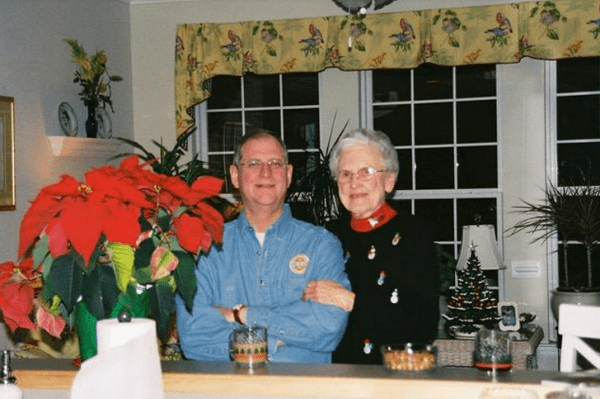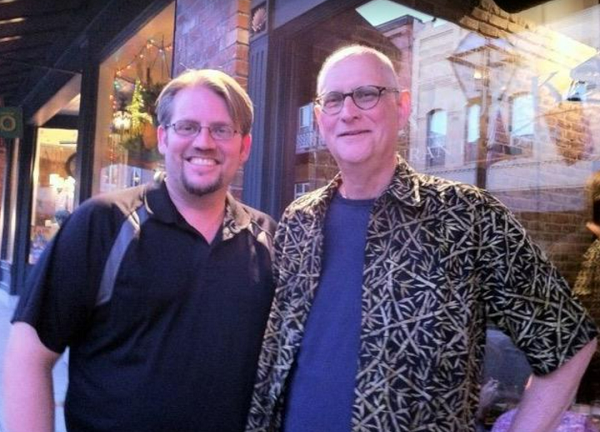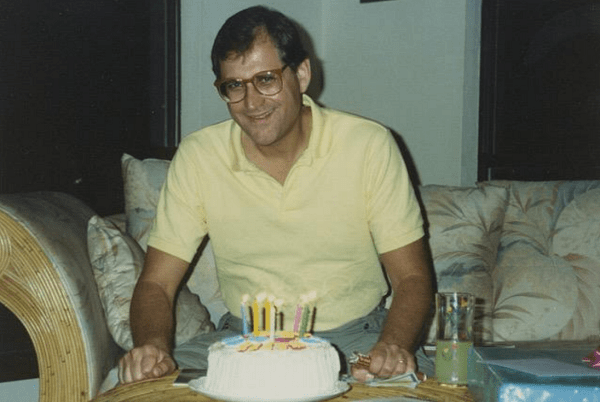
Jerry and his mother, Candace Shook
Compiled by David Celiberti, PhD, BCBA-D
Association for Science in Autism Treatment
Participants:
James Carr, PhD, BCBA-D
Behavior Analysis Certification Board
Gina Green, PhD, BCBA-D
Association of Professional Behavior Analysts
Suzanne Buchanan, Psy.D., BCBA-D
Autism New Jersey
Mary Jane Weiss, PhD, BCBA-D
Endicott College and the Association for Science in Autism Treatment
Lorri Unumb, Esq
The Council of Autism Service Providers
One of the greatest visionaries in the field of applied behavior analysis, Dr. Jerry Shook passed away on November 11, 2011. Prior to his death, we compiled a series of tributes to Jerry which were read to him. I am so grateful that we had the opportunity to share our sentiments and heartfelt appreciation with him. Fast forward ten years later and we have set forth to celebrate his enduring impact with the following collection of reflections. Drs. Jim Carr and Suzanne Buchanan participated in the original series of tributes and re-joined this effort. I invited Drs. Gina Green and Mary Jane Weiss, as well as Lorri Unumb, Esq., to share their thoughts.
| “I want to make sure those who cannot speak for themselves are given a voice through the most qualified help they can get.” – Dr. Jerry Shook |
David Celiberti: It’s so hard to believe that ten years have come and gone since our professional community experienced the untimely passing of Jerry Shook. As we look back on his important work through the lens of 2021, what do you believe was his most indelible imprint?
James Carr: It was definitely his vision in the 1990s that our nascent profession would soon need a widely available certification program in behavior analysis. Jerry founded the Behavior Analyst Certification Board (BACB) in 1998 and spent the next 13 years disseminating information about the organization and its certification programs, developing the organization’s operational capacity, and refining and elevating the Board Certified Behavior Analyst (BCBA) and Board Certified Assistant Behavior Analyst (BCaBA) certification programs. Just after this period, the rapid proliferation of new funding streams for autism treatment across the U.S. stimulated the development of new service organizations and new university training programs, which eventually led to an explosion of new certification applicants. Had Jerry not acted on his vision when he did, our professional landscape over the past decade would have been substantially more challenging than it has been. It is difficult to imagine what we would have done with dozens of new funding streams and new university training programs, but no existing certification system to support the new workforce.

Jerry and James Carr
Suzanne Buchanan: I remember Jerry as someone who was driven to increase access to bona fide and effective ABA services, and, as the Executive Director of Autism New Jersey and regular reader of SIAT, I view his legacy through the lens of the autism community. Prior to the establishment of the BACB in 1998, parents of children with autism could review an unfamiliar and daunting array of qualifications to determine if an ABA practitioner had sufficient training and experience. Jerry’s vision, leadership, and hard work were instrumental in creating a national standard for board certification in behavior analysis and credentials that made a parent’s job much easier because it quickly conveyed that a professional had met the minimum standard of the profession. Thus, I view Jerry’s most indelible imprint as his unwavering commitment to professionalizing the practice of behavior analysis for future generations.
Lorri Unumb: What struck me most about Jerry was his incredible vision. He foresaw that the field of behavior analysis needed some kind of regulation, and since state regulation was not happening at that time, he envisioned private regulation through certification. And then he made it happen! Looking back from 2021, one might not appreciate how much foresight such an endeavor required. When Jerry was creating the BACB, insurance coverage for applied behavior analysis was essentially non-existent. It’s one thing to foresee a need for regulation in a world where insurers play a major reimbursement role; it’s quite another thing to foresee this need in a pre-insurance world. Jerry saw the future and tackled a forthcoming problem.
Mary Jane Weiss: Jerry’s work led to the recognition of the profession of behavior analysis. Before certification, there were pockets where people did behavior analytic work, but there was not a coherent, dedicated profession with a defined scope of training and an identified set of associated competencies. Jerry created a standard that laid the groundwork for the professionalization of behavior analysis. Everything that followed was possible because of his initial insights into those early and defining steps. It is almost impossible to imagine where we would be without his efforts. Honestly, his vision was extraordinary. He anticipated the needs of the consumers, and he enacted a model of training that prepared a workforce to meet those consumers’ needs.
David Celiberti: Thank you all for your comments. In order to understand his impact, one must understand the professional climate at the time that certification was first being put into place as many of you have alluded to above. More specifically, many young professionals may not appreciate the hurdles that Jerry had to overcome in the early years of establishing the BACB. In your view, what were some of these early challenges faced by Jerry that have been forgotten or can easily be taken for granted today?
James Carr: There were so many challenges, but I will share two. First, Jerry had to demonstrate to the leadership, faculty, students, and practitioners in behavior analysis that certification programs were needed. This is always a challenging juncture in a profession’s developmental timeline. After all, behavior analysis had made it through the 1990s without widely available certification; many questioned why such a big initiative was necessary at the time. Thus, Jerry’s early years at the BACB involved a grueling dissemination campaign that took him to countless conferences and universities. Indeed, when I took the paper-and-pencil BCBA certification exam along with a few faculty members and graduate students in 2001, Jerry served as our proctor in a dingy old university classroom. This is not a typical duty of a CEO, but Jerry did what was needed at the time. The second challenge was financial in nature. The revenue of certification organizations largely comes from initial and recertification fees. There was not much revenue in the BACB’s early years because there were relatively few applicants, and recertification fees obviously were not collected until certificants needed to recertify at a later point. Consequently, Jerry did not take a salary for almost the first three years of his service as the BACB’s CEO. He “kept the wheels on the bus” by securing modest donations from other organizations and borrowing operational resources from his wife’s (BJ Quinn) court reporting business. Needless to say, Jerry undertook considerable effort and sacrifice to start the BACB. We all should be grateful that he did.
Gina Green: I was on the Executive Council of the Association for Behavior Analysis with Jerry when he founded the BACB, and was privileged to serve on the BACB Board of Directors for 6 years starting in 2000, not long after the organization was established. One early challenge was overcoming resistance to the prospect of certifying ABA practitioners from some sources within the field – surprising to me, given that that topic had been discussed for years. Fortunately, there was strong support from many parents of children with autism, including Catherine Maurice, as well as several state behavior analysis associations whose constituents included lots of practitioners. Those and other supporters recognized the need for credentials signifying that individuals who purported to practice ABA had met objective, uniform requirements for education and experiential training in behavior analysis, had demonstrated basic knowledge of the subject matter by passing a professional exam, and were expected to adhere to ethical standards specific to the practice of ABA, just like practitioners in many other fields. It takes a tremendous amount of expertise and resources to develop professional credentialing programs that meet those criteria. Few people may know or remember that in order to get the BACB off the ground, Jerry worked as Executive Director without pay for the first few years.
Another early challenge was setting up procedures for establishing the requirements for obtaining and maintaining BACB certifications that would enable the credentialing programs to be accredited by the National Commission for Certifying Agencies (NCCA) of the Institute for Credentialing Excellence. Jerry and Jim Johnston, first President of the BACB, understood from the outset that meeting the NCCA’s rigorous standards for high-quality, legally defensible professional certification programs was essential for protecting the public, achieving parity with other professions, and establishing a foundation for state licensure of ABA practitioners. So early on, Jerry secured the services of individuals with expertise in the areas of psychometrics and law that were needed to help the BACB achieve and maintain NCCA accreditation of its certification programs. I have a hunch that even now, relatively few young – or even older – behavior analysts appreciate the value and protections that are afforded by the longstanding oversight of the BACB programs by the NCCA and Jerry’s foresight. The same goes for his foresight in establishing the BACB as a nonprofit credentialing body that is independent of any for-profit companies or other nonprofit organizations.

Jerry and his birthday cake
Mary Jane Weiss: I think we all owe Jerry for creating the profession with which we all now identify. When Jerry embarked on this journey, people were not familiar with behavior analysis. He was often in the position of educating others about behavior analysis as a science, as a model of intervention, and as an evidence-based approach for individuals with autism. In the latter context, Jerry was educating people about the dangers of uncredentialed service providers. Certification emerged in an era when early intensive behavioral intervention experienced an explosive demand, following the publication of Let me Hear your Voice. As parents advocated for intensive ABA, many providers attempted to meet the challenge. Some of these providers lacked the breadth and depth of training to effectively meet the needs of individuals they served, and intervention quality was variable and often frighteningly poor in quality. Jerry envisioned a solution: the creation of a professional credential enabled families and schools to identify individuals who possessed the necessary skills. In this way, consumers were protected from ineffective treatment from inadequately prepared individuals. This was the most significant challenge facing the field in the early days, and certification ensured that quality treatment would be available and that competency in practitioners would be identifiable.
Lorri Unumb: I don’t think we even know the breadth of the hurdles that Jerry faced. I imagine that one major hurdle was convincing the outside world that behavior analysis was actually a profession. Even after the BACB was founded, I had trouble convincing legislators that behavior analysis was a real discipline, that being a behavior analyst was a real profession, and that BACB certification was a real credential. I remember one legislator scoffing at the BACB certification process and asking whether I found an ad for it in the back of a magazine and whether one could get their “certification” in a weekend course! Jerry faced these battles over the years and created a professional organization that catapulted the profession into the position of legitimacy that it deserved.
David Celiberti: What are some new challenges to the credentialing of behavior analysts that have emerged or become more pronounced in the last ten years? Based on your relationship and history with Jerry, how do you think he may have approached these?
Gina Green: Pressures for governmental regulation of ABA practitioners – most commonly, licensure – have increased over the past decade. Licensure was certainly on Jerry’s radar when he founded the BACB, and probably even before that as he worked with its predecessor, the State of Florida’s behavior analyst certification program. Due to his experience in state government, Jerry appreciated the value of good licensure laws as well as the challenges in getting such laws adopted and implemented. His understanding of the need to advocate for public policies to support the practice of ABA led him to help found the Association of Professional Behavior Analysts in 2007. I’m very grateful for that, and for the fact that he was here to educate and guide me and others who worked on the first few behavior analyst licensure laws. Like many of us, I don’t think Jerry fully anticipated the tremendous growth in the practice of ABA and the concomitant public policies that have been spurred by the autism insurance reform movement. I hope he would be pleased that as of now, 33 U.S. states have adopted laws to license behavior analysts (thereby recognizing the practice of ABA as a distinct profession), and that in most of them, BACB certification is a qualification for state licensure. I think Jerry might be dismayed, however, by some of the opposition to licensing behavior analysts that has arisen, the push from some quarters for licensure standards that contradict best practices and case law in professional credentialing, and the influence of financial interests on the field.
When working on licensure laws and other public policies, I often ask myself “What would Jerry do?” I think his approach to the current challenges would be the same as always: calm, objective, fact-based, and always keeping the best interests of consumers of ABA services and the integrity of the profession at the forefront.
Lorri Unumb: Some of the new challenges of the last ten years are volume, competition, and due process.
- Volume: I’m not sure that even the great Jerry Shook could have foreseen the astronomical rapid growth in the profession. While the BACB has handled it very well, such growth/volume clearly puts a strain on any organization.
- Competition: It’s difficult for a young profession to establish and prove itself in all of the various constituencies that are relevant to its existence; it’s even more difficult to do so when there’s competition within the field. While I believe in a free market, I think the existence of competing certifying bodies in an adolescent field makes our advocacy work more difficult, not less.
- Due Process: As the practice of behavior analysis exponentially grows, so too does the complexity of certifying and regulating the field. The BACB maintains the ethics mechanism that has been critical to establishing the legitimacy of the profession, but now state licensure boards also regulate behavior analysts in most states. How should the two work together? Who is responsible for ensuring the ethical practice of behavior analysis, who is entitled to deprive a practitioner of the right to practice, and what processes are in place to ensure fair procedures? All of these issues become more important as an increasing number of people make behavior analysis their profession and livelihood.

Jerry, the world traveler, representing the BACB
How would Jerry have approached these? With an open mind and a healthy dose of grace. Jerry was such a lovely person with whom to work. He sought the advice of others, listened with great curiosity, and never thought he knew more than anyone else. He welcomed constructive criticism and strove to continually improve the BACB and the profession. He poured blood, sweat, and tears into the organization. When I met Jerry, I was just an autism mom, like thousands of others he had met before. I did not work for CASP or Autism Speaks or run the Autism Law Summit or hold any other positions within the fields of autism or ABA. I reached out to him as a mom when I was trying to get autism insurance legislation passed in my own state of South Carolina. He gave generously of his time, offered support and advice, and helped me immensely on my advocacy journey. I had so much respect for his accomplishments and his approach, and to this day I remain grateful for his assistance and friendship as I tiptoed unknown into this field.
Suzanne Buchanan: I always found Jerry to be very thoughtful and well-informed about a broad range of issues related to the professionalization of a field, so I’m guessing he predicted many of our current challenges. He was keenly aware of the risks associated with increased recognition, regulation, and licensure of the profession and recommended that advocacy efforts proceed with care and caution. Here in New Jersey, we relied on that sage advice to avoid some of the very real risks of pursuing licensure, for example. We proceeded with our advocacy for the Applied Behavior Analyst Licensing Act when and only when we were likely to be successful (e.g., independent licensure board, BACB certificants as the first licensure board members, no scope restrictions). We also followed his lead on demonstrating a strategic combination of collaboration and assertiveness with legislators, state agencies, related professions, and fellow disability organizations to ensure legislative language that offered the best possible outcome for the profession and consumers.
David Celiberti: As we look to the future, how can we best honor his legacy?
Suzanne Buchanan: Jerry was a humble and disciplined visionary, and I think we each have a role to play in honoring his legacy. Individually, we can all be humble, unassuming, and compassionate as well as disciplined with a goal-oriented and laser focus on what’s most important in our clients’ lives. More broadly, we can all become more visionary by learning and talking more about the increasingly complex contexts (e.g., economic, social, political) in which our profession operates now and into the next few decades. As Jerry taught us, more clearly seeing our future allows us to take a more substantial role in shaping it for the greater good.
Gina Green: In my opinion, one of the best ways to perpetuate Jerry’s legacy is to work to bring his vision of behavior analysis as a licensed profession to fruition. Another is to try to counter misinformation and disinformation about the BACB, its credentialing programs, and Jerry’s work by politely directing folks to factual information on the BACB website and in numerous publications. The very best thing practitioners can do is to study his work, emulate his dedication and professionalism, and strive to provide their clients with the most effective, caring, science-based services possible.
James Carr: I think the best way that BACB certificants can honor Jerry’s legacy is to actively pursue a rigorous professional development program to keep elevating their core skill sets. Certification eligibility requirements relate to one’s entry into a profession. Thus, obtaining BACB certification indicates that one’s journey has begun, not that it has ended. Jerry started the BACB with a consumer protection function in mind. I can’t imagine anything he would be more pleased with than seeing an army of certified behavior analyst professionals consistently leveling up their skills to more effectively serve their clients.
Mary Jane Weiss: I am sure Jerry would be proud of what we have done to increase access to services for families of children with autism, and to create a professional workforce of behavior analysts throughout the county. We can honor his legacy by continually raising the bar; Jerry’s vison was one of never-ending improvement in access and quality. The quest never ends, and the opportunity to improve is continual. I also think that Jerry was one of the kindest collaborators, whose professionalism was always evident and whose grace never faltered. When there was disagreement, or a difference in vision, Jerry persisted in dialogue, seeking common ground and finding resolutions. In these divisive times, we can all benefit from this model of professional excellence; Jerry treated everyone he encountered with compassion and respect. He was, and is, an extraordinary example of how we should all behave in our professional lives, in our personal dealings with others, and in how we represent the profession.
Citation for this article:
Celiberti, D. (2021). Some reflections on the enduring legacy of Dr. Jerry Shook: A conversation with James Carr, Gina Green, Suzanne Buchanan, Mary Jane Weiss, and Lorri Unumb. Science in Autism Treatment, 18(11).
Other ASAT Tributes:

